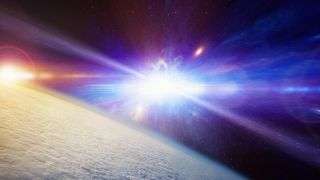
An ancient supernova explosion may have disrupted Earth’s ozone layer and caused the extinction of entire ecosystems.
A global extinction event around 359 million years ago may have been triggered by the death blast of a distant star, a new study suggests.
Toward the end of the Devonian period (416 million to 358 million years ago), there was a mass extinction known as the Hangenberg Event; it wiped out armored fish called placoderms and killed off approximately 70% of Earth’s invertebrate species. But scientists have long puzzled over what caused the die-off.
Recently, preserved plant spores offered clues about this ancient extinction. Fossil spores spanning thousands of years at the boundary of the Devonian and the Carboniferous periods showed signs of damage by ultraviolet (UV) light. This find suggested that a cataclysmic event had caused a long-lasting disruption of Earth’s ozone layer, which shields the planet from harmful UV rays. Scientists proposed that a likely candidate for this blast of UV light could be one or more supernovas that exploded within 65 light-years from Earth, according to a new study.
Climate change and extreme volcanic activity can also damage the ozone layer, but evidence in the geologic record at the end of the Devonian couldn’t clearly link the ozone depletion to a global disaster that originated on Earth, the study authors reported.
When stars die, they release blasts of UV light, X-rays and gamma rays. If a supernova is close enough to Earth, these rays can shred the ozone layer, exposing Earth to unfiltered UV light from the sun and harming life on the planet’s surface. However, this damage is typically short-lived. Its effects fade after a year or so, “and after a decade, Earth restores its ozone,” said lead study author Brian Fields, a professor in the Department of Astronomy at the University of Illinois Urbana-Champaign.
But that initial bombardment is just the first stage of the damage a neighboring supernova can inflict, Fields told Live Science in an email.
“Later, the supernova blast slams into the solar system. The blast acts as a particle accelerator, and the Earth is bathed with an intense rain of high-energy particles,” which are known as muons, Fields said. Not only does this blast strip away Earth’s ozone layer — again — muons then irradiate Earth’s surface and penetrate deep underground and into the oceans.
“These will damage life, and the cosmic rays will linger for many thousands of years, up to 100,000 years,” Fields said. If a supernova — or more than one — shredded Earth’s ozone layer, that could explain the UV damage found in Late Devonian spores and pollen over millennia, the researchers reported.
Light years away
How close does a star have to be for its death to affect Earth?
“Work by my co-authors and others has shown that a supernova about 25 light-years away would lead to biological cataclysm — a true mass extinction,” Fields said. “For context, the nearest star today is 4 light-years away,” he added. As the Hangenberg extinction was less severe than other mass extinctions in Earth’s history, the study authors estimated that the Devonian supernova would have exploded about 65 light-years away (though, there is not yet a potential candidate for a star in this range that died 359 million years ago).
Related Content
– 15 unforgettable images of stars
– The 12 strangest objects in the universe
– The 10 greatest explosions ever
The good news is that you don’t need to worry about a supernova upending life as we know it — at least, not anytime soon.
“I am pleased to report that no threatening supernova candidates are anywhere near the ‘minimum safe distance,'” at which Earth could be harmed by a supernova, Fields told Live Science.
In recent months, scientists’ attention has focused on unusual dimming in the red giant Betelgeuse, which is in its final life stages and is expected to explode in a spectacular supernova relatively soon (in astronomical terms) — within about 100,000 years.
Betelgeuse is about 1,000 times the size of our sun, so that explosion should be quite spectacular. But at more than 642 light-years from Earth, “it is far enough that the fireworks will be harmless to us,” Fields said.
The findings were published online Aug. 18 in the journal Proceedings of the National Academy of Sciences.
Sourse: www.livescience.com





